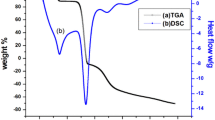Abstract
The influence of the state of interfaces on the magnetoresistive properties of Co/Cu superlattices has been studied by the methods of nuclear magnetic resonance and X-ray reflectometry. It has been found that the magnetron-sputtered superlattices with the highest value of the giant magnetoresistance effect have the largest fraction of highly perfect Co/Cu interlayer boundaries, as well as practically the smallest fraction of cobalt atoms localized in the interfaces.










Similar content being viewed by others
References
K. Wetzig, C.M. Schneider, Metal based thin films for electronics (WILEYVCH GmbH & Co. KGaA, Weinheim, 2003)
J.C. Mallinson, Magnetoresistive and spin valve heads. Fundamentals and applications (Academic Press, San Diego, 2002)
S.S.P. Parkin, R. Bhadra, K.P. Roche, Oscillatory magnetic exchange coupling through thin copper layers. Phys. Rev. Lett. 66, 2152 (1991)
E.E. Fullerton, I.K. Schuller, H. Vanderstraeten, Y. Bruynseraede, Structural refinement of superlattices from X-ray diffraction. Phys. Rev. B. 45(16), 9292 (1992)
C.H. Marrows, N. Wiser, B.J. Hickey, T.P.A. Hase, B.K. Tanner, Giant magnetoresistance and oscillatory exchange coupling in disordered Co/Cu multilayers. J. Phys. Condens. Matter. 11, 81 (1999)
T. Shinjo, T. Emoto, Y. Kawawake, K. Mibu, N. Hosoito, Mossbauer study of Cu/Co and Au/Co multilayers using 119Sn. J. Magn. Magn. Mater. 140–144, 619 (1995)
N.V. Kourtina, E.A. Kravtsov, V.V. Ustinov, Method of the reflections function in the X-ray reflectometry study of multilayers. J. Magn. Magn. Mater. 240, 494 (2002)
C. Meny, P. Panissod, R. Loloee, Structural study of cobalt-copper multilayers by NMR. Phys. Rev. B. 45, 12269 (1992)
T. Thomson, P.C. Riedi, NMR studies of interfaces, strain and anisotropy in Co/Cu multilayers. Hyperfine Interact. 120, 20 (1999)
E. Jedryka, M. Wójcik, S. Nadolski, Effect of deposition sequence on interface intermixing in Cu/Co/Ru and Ru/Co/Cu multilayers studied by NMR. J. Appl. Phys 91, 7191 (2002)
S.A. Chuprakov, T.P. Krinitsina, N.S. Bannikova, I.V. Blinov, S.V. Verkhovskii, M.A. Milyaev, V.V. Popov, V.V. Ustinov, Interface structure and magnetoresistance studies of [Co/C]n superlattices by means of NMR and TEM. Solid State Phenom. 215, 358 (2014)
S.A. Chuprakov, N.S. Bannikova, I.V. Blinov, T.P. Krinitsina, M.A. Milyaev, V.V. Popov, V.V. Ustinov, Investigation of interfaces of multilayer Co/Cu structures using the method of nuclear magnetic resonance. Phys. Metals Metallogr. 116, 136 (2015)
T.S. Plaskett, T.R. McGuire, Magnetoresistance in (Co10 Å/Cu10 Å)n multilayer films as n increases. J. Appl. Phys. 73, 6378 (1993)
E.Y. Tsymbal, Effect of disorder on perpendicular magnetotransport in Co/Cu multilayers. Phys. Rev. B. 6, 3608 (2000)
S.S.P. Parkin, A. Modak, D.J. Smith, Dependence of giant magnetoresistance on Cu-layer thickness in Co/Cu multilayers: a simple dilution effect. Phys. Rev. B. 47, 9136 (1993)
J. Mathon, Ab ignition calculation of the perpendicular giant magnetoresistance of finite Co/Cu(001) and Fe/Cr(001) superlattices with fluctuating layer thickness. Phys. Rev. B 55, 960 (1997)
S.A. Chuprakov, N.S. Bannikova, I.V. Blinov, T.P. Krinitsina, M.A. Milyaev, V.V. Popov, V.V. Ustinov, Study of the structure of interlayer boundaries in [Co/Cu]10 superlattices by methods of NMR and X-ray reflectometry. Phys. Metals Metallogr. 117, 1192 (2016)
W.-Y. Lee, M.F. Toney, P. Tameerug, E. Allen, D. Mauri, High magnetoresistance permalloy films deposited on a thin NiFeCr or NiCr underlayer. J. Appl. Phys. 9, 6992 (2000)
V.A. Vas’ko, M.T. Kief, Effect of grain size on the properties of the CoFe–NiFe/NiMn top spin valve. J. Appl. Phys. 93, 8409 (2003)
A.A. Maradudin, Light scattering and nanoscale surface roughness (Springer Science, New York, 2007)
T. Thomson, P.C. Riedi, D. Greig, Interfacial quality and giant magnetoresistance in MBE-grown Co/Cu(111) superlattices. Phys. Rev. B. 50, 10319 (1994)
H.A.M. Gronckel, K. Kopinga, W.J.M. Jonge, P. Panissod, J.P. Schille, F.J.A. Broeder, Nanostructure of Co/Cu multilayers. Phys. Rev. B. 44, 9100 (1991)
T. Nasu, H. Yasuoka, Y. Nakamura, Y. Murakami, Hyperfine field distribution in Co–Cu alloy: 59Co nuclear magnetic resonance. Acta Met. 22, 1057 (1974)
V.I. Chizhik, Y.S. Chernyshev, A.V. Donets, V. Frolov, A. Komolkin, M.G. Shelyapina, Magnetic Resonance and Its Applications (Springer, Berlin, 2014), p.782
M.I. Kurkin, E.A. Turov, Nuclear Magnetic Resonance in Magnetically Ordered Substances and Its Application (Nauka, Moscow, 1990). (in Russian)
Acknowledgements
X-ray studies were carried out using the equipment of the Collaborative Access Center «Testing Center of Nanotechnology and Advanced Materials» of the IMP UB RAS.
Funding
The results were obtained within the state assignment of Ministry of Science and Higher Education of the Russian Federation (theme “Function” No. 122021000035-6).
Author information
Authors and Affiliations
Contributions
SAC: conceptualization, investigation, writing. NSB: MR investigation. IVB: writing. MAM: conceptualization. VVO: conceptualization, supervision. VVP: conceptualization, VVU: conceptualization, supervision.
Corresponding author
Ethics declarations
Competing interests
The authors declare no competing interests.
Conflict of interest
The authors declare that they have no known competing financial interests or personal relationships that could have appeared to influence the work reported in this paper.
Additional information
Publisher's Note
Springer Nature remains neutral with regard to jurisdictional claims in published maps and institutional affiliations.
Rights and permissions
Springer Nature or its licensor holds exclusive rights to this article under a publishing agreement with the author(s) or other rightsholder(s); author self-archiving of the accepted manuscript version of this article is solely governed by the terms of such publishing agreement and applicable law.
About this article
Cite this article
Chuprakov, S.A., Bannikova, N.S., Blinov, I.V. et al. Effect of the State of Interlayer Boundaries on the Magnetoresistive Properties of Layered Co/Cu Nanostructures. Appl Magn Reson 53, 1621–1632 (2022). https://doi.org/10.1007/s00723-022-01494-8
Received:
Revised:
Accepted:
Published:
Issue Date:
DOI: https://doi.org/10.1007/s00723-022-01494-8




